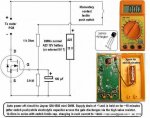So, I've been looking at the circuit diagrams...and I have a question.
Most of the self-powered PICAXE circuits (where a momentary switch powers up the PICAXE, and then the PICAXE itself holds a transistor "on" to maintain power...) show two transistors...the PICAXE drives and NPN which in turn, drives a PNP which supplies the power to the PICAXE.
It seems like this could be done with a single transistor...an NPN on the GROUND side of the PICAXE...and having the momentary switch being on the ground side of the circuit vs the positive...is this possible?
As I type this, I'm wondering if there are concerns with the PICAXE powering itself via a different path if the positive is always "hot"...allowing the PICAXE to power through one of the other pins?
Also, would a single NPN on the negative rail result in the PICAXE being at a different ground potential than the rest of the circuit given the CE Saturation voltage?
I think I'm answering my own questions here, but would like some input.
I'm building a little light circuit that I would like to have turn itself off after 30 minutes.
Thanks everybody!
Most of the self-powered PICAXE circuits (where a momentary switch powers up the PICAXE, and then the PICAXE itself holds a transistor "on" to maintain power...) show two transistors...the PICAXE drives and NPN which in turn, drives a PNP which supplies the power to the PICAXE.
It seems like this could be done with a single transistor...an NPN on the GROUND side of the PICAXE...and having the momentary switch being on the ground side of the circuit vs the positive...is this possible?
As I type this, I'm wondering if there are concerns with the PICAXE powering itself via a different path if the positive is always "hot"...allowing the PICAXE to power through one of the other pins?
Also, would a single NPN on the negative rail result in the PICAXE being at a different ground potential than the rest of the circuit given the CE Saturation voltage?
I think I'm answering my own questions here, but would like some input.
I'm building a little light circuit that I would like to have turn itself off after 30 minutes.
Thanks everybody!


